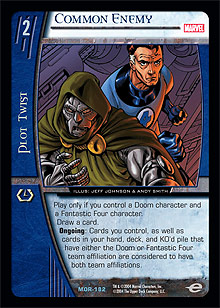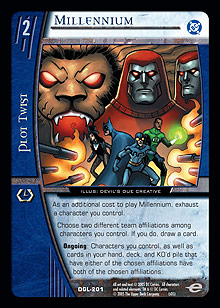When we were first designing the game, we turned a critical eye toward understanding how players would choose characters for inclusion in decks. From a design philosophy standpoint, we wanted players to have as many choices as possible while still encouraging the traditional team-based model that was featured in comics. Ultimately, we picked an engine direction that allowed players to take a wide selection of characters from multiple teams and bring them into play with the same ease that a deck with characters from a single team could.
One danger of this design approach was the fear that players would always pick the strongest character (in statistics or power) at each drop point, so instead of having a diverse tournament environment, only one or two deck designs would be competitive. To provide a counterbalance to this recruitment freedom, we created ways for teammates to take advantage of certain game rules and cards, such as team attacks, reinforcement, and team-stamped plot twists, equipment, and locations.
 With these game rules in place, we started to look at cards that would help facilitate decks with two or more teams. The first generation of team-ups came in two varieties. The first was a cycle of cards, including Common Enemy and The Brave and the Bold, that looked for two specific teams and provided a card draw as a reward for teaming-up. The second was the Marvel Team-Up/World’s Finest variety, which had the flexibility of choosing any two team affiliations but didn’t provide any additional benefits beyond allowing the two teams to team attack, reinforce, and gain access to the other team’s plot twists, equipment, and locations.
With these game rules in place, we started to look at cards that would help facilitate decks with two or more teams. The first generation of team-ups came in two varieties. The first was a cycle of cards, including Common Enemy and The Brave and the Bold, that looked for two specific teams and provided a card draw as a reward for teaming-up. The second was the Marvel Team-Up/World’s Finest variety, which had the flexibility of choosing any two team affiliations but didn’t provide any additional benefits beyond allowing the two teams to team attack, reinforce, and gain access to the other team’s plot twists, equipment, and locations.
The card-drawing component of Common Enemy and The Brave and the Bold provided a strong incentive for putting four copies of them into a deck. Not only would doing so potentially allow a player to pull one earlier in the game, but it would also allow him or her to cycle through later copies that are drawn when they’re not needed. The downside of these cards was that they only allowed for specific teams within a given comic universe to get the benefit of the card draw. While Marvel Team-Up and World’s Finest worked for any team we would ever release, additional copies drawn later in the game only served as a safety net against cards like Foiled and Have a Blast!.
In the Spider-Man set, we began to evolve how team-up cards would allow for the creation of two-team decks and what different kinds of rewards they could grant. Clone Saga allowed for affiliated non–Spider-Friends characters to gain the Spider-Friends affiliation. This widened the affiliation-sharing component of the team-up to include potentially any number of other character affiliations in play. It also only required that you control a Spider-Friends character to play, whereas the previous team-ups required two different teams to be in play first. The tradeoff was that your Spider-Friends characters didn’t gain the other team affiliations.
Forced Allegiance was also introduced in this set. This team-up worked for any one team of your choice and turned all other characters you controlled into members of that team. You gained all the benefits of team attacking and reinforcement but lost the ability to play plot twists, equipment, and locations from the other teams. The evolution for the Spider-Man set was allowing more than two teams to be teamed-up with a single card.
 The Superman set brought us Royal Decree. This team-up was a blending of the Origins team-up cards. It allowed a player to team-up any two teams of his or her choice, and if the player picked New Gods, then he or she could also draw a card. Also in the Superman set was Metropolis, the first location team-up. The evolution for the Superman set was a World’s Finest–style team-up that could crossover any two teams with an additional bonus if one of the chosen teams was New Gods. In addition, team-up effects were no longer limited to just ongoing plot twists.
The Superman set brought us Royal Decree. This team-up was a blending of the Origins team-up cards. It allowed a player to team-up any two teams of his or her choice, and if the player picked New Gods, then he or she could also draw a card. Also in the Superman set was Metropolis, the first location team-up. The evolution for the Superman set was a World’s Finest–style team-up that could crossover any two teams with an additional bonus if one of the chosen teams was New Gods. In addition, team-up effects were no longer limited to just ongoing plot twists.
Team-up cards and effects took a huge leap forward in the Marvel Knights set. One of the design directions for this expansion was to increase the ease and power of teaming-up. The defining team-up for Marvel Knights was Midnight Sons. While limited to the Marvel Knights team, it was the first team-up that provided full team-up benefits without first needing a character from the other team in play. This added a tremendous amount of flexibility in deck design and was further enhanced by characters such as Dagger, Child of Light, who could search for the team-up while it was still in a player’s deck. The evolutions for the Marvel Knights set were the requiring of only one of the two teams to be in play for a team-up to be used and the creation of characters that could help to ensure that players got their team-ups early in the game.
 Continuing the advancement of the team-up class of card, the Green Lantern set further added to the category with Hard-Traveling Heroes, Millennium, and No Evil Shall Escape Our Sight. Hard-Traveling Heroes and No Evil Shall Escape Our Sight were the first team-up cards to feature mechanics that were directly linked to new keywords introduced in the set. Hard-Traveling Heroes was linked to the willpower mechanic while providing the traditional benefits of a card draw along with the potential ability to team-up more than two teams. No Evil Shall Escape Our Sight was a Construct and the first team-up to feature text on the version line. Last but not least, Millennium allowed players to get the best features from the two DC Origins team-up types (choosing any two teams and getting a card draw) all in one card, at the cost of exhausting a character. The evolution for the Green Lantern set were teams-ups designed to incorporate new set mechanics.
Continuing the advancement of the team-up class of card, the Green Lantern set further added to the category with Hard-Traveling Heroes, Millennium, and No Evil Shall Escape Our Sight. Hard-Traveling Heroes and No Evil Shall Escape Our Sight were the first team-up cards to feature mechanics that were directly linked to new keywords introduced in the set. Hard-Traveling Heroes was linked to the willpower mechanic while providing the traditional benefits of a card draw along with the potential ability to team-up more than two teams. No Evil Shall Escape Our Sight was a Construct and the first team-up to feature text on the version line. Last but not least, Millennium allowed players to get the best features from the two DC Origins team-up types (choosing any two teams and getting a card draw) all in one card, at the cost of exhausting a character. The evolution for the Green Lantern set were teams-ups designed to incorporate new set mechanics.
Following the advancement of the Construct-version team-up in Green Lantern, all team-up cards in the Avengers set were given the version “Team-Up.” Team-Ups had finally become a formalized category of card with specific game rules beyond the effects they provided. Cards like Behavior Modification Device also expanded the types of rewards that Team-Ups could provide beyond the traditional “draw a card” effect. While outside the scope of traditional Team-Up effects, the Avengers set also introduced leader characters, a number of which granted their team affiliation to adjacent characters. The evolution for the Avengers set was that Team-Ups became a standardized category of card that could be referenced by other effects and provide benefits beyond drawing a card. In addition to plot twists and locations, leader characters could also provide Team-Up–type effects.
The major teaming-up mechanic for the JLA set didn’t appear on plot twist cards at all. Instead, the defining multi-team enabler cards for this set were the dual affiliation characters. These characters came with two printed team affiliations and could find homes in decks of either affiliation without the need of a Team-Up. As more of these characters are introduced in upcoming sets, the concept of the multi-team deck will need to be completely redefined. Following the direction of the Avengers Team-Up plot twists, the JLA Team-Ups also included reward effects that went beyond drawing a card. These effects further defined the mechanical role of a deck that contained characters from two different teams. The evolution for the JLA set was dual-affiliated characters turning the concept of needing Team-Ups in decks on its ear.
 Now, we come to the X-Men set. After two years of players looking at the words, “Characters you control, as well as cards in your deck, hand, and KO’d pile that have either of the chosen affiliations have both of the chosen affiliations,” R&D finally created the single keyword “crossover” to reduce twenty-seven words down to one. By saving four lines of text space, the X-Men Team-Up cards could generate game-altering reward effects that previous Team-Ups simply didn’t have room for.
Now, we come to the X-Men set. After two years of players looking at the words, “Characters you control, as well as cards in your deck, hand, and KO’d pile that have either of the chosen affiliations have both of the chosen affiliations,” R&D finally created the single keyword “crossover” to reduce twenty-seven words down to one. By saving four lines of text space, the X-Men Team-Up cards could generate game-altering reward effects that previous Team-Ups simply didn’t have room for.
Similar to the Green Lantern expansion, many of the X-Men Team-Ups help support a new game mechanic for the set. Another interesting innovation for the affiliation-specific Team-Ups in the set is their ability to be useful in a Sealed Pack environment where a player has no use for crossover effects. Team-Ups like X-Men United provide standardized plot twist–type effects that have game function in a mono-team deck. The evolutions in the X-Men set are freeing up four lines of game text by creating a single keyword and the creation of Team-Up cards that generate useful game effects in decks that have only a single team in play.
Team-up cards have come a long way in the last two years. The upcoming Infinite Crisis and Heralds of Galactus sets will continue this evolutionary process and further expand this category of card within the game. Until then, keep building your Fearsome Five/Deathstroke/Skrull deck, and I’ll see you at the game store.